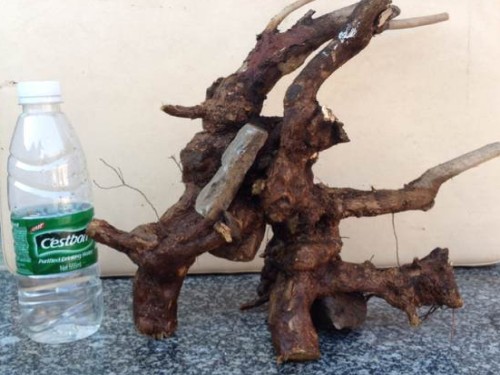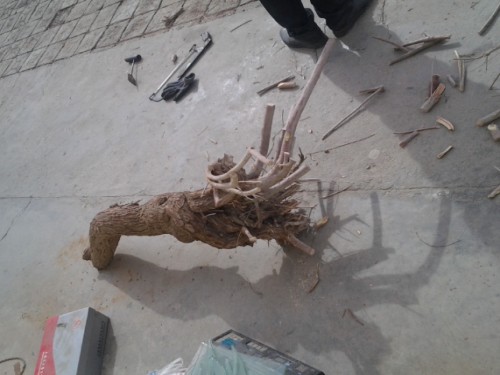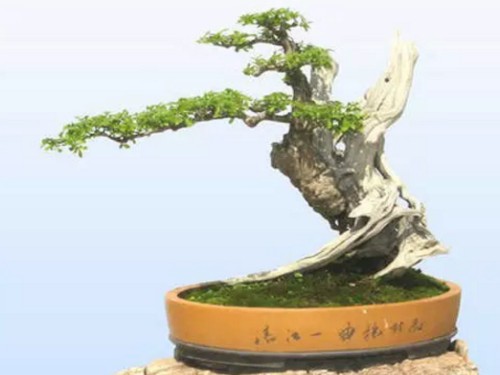The method of excavating bonsai piles in the field
The older the bonsai is, the higher the value is. Although wild pile excavation can not be used as the main material source of mass production because of its rare materials, it can be used as an auxiliary means to make characteristic bonsai. It is characterized by rapid shaping and easy to reflect the quaint charm of bonsai, but destroys wild plant resources. Therefore, we must investigate before digging to avoid blindness and waste.

The main results are as follows: 1. The method of digging wild tree stumps is suitable for making old stumps of bonsai, which generally grow in stone cracks in barren mountain cliffs with poor conditions. In late autumn and early winter or early spring, the selected stump will first saw off the thick branches of the ground, leaving only a section at the base, and cut off the useless branches, and then clear around the stump for excavation. When digging, dig deep on one side. If there is a main root, cut off the main root first, and then cut the lateral root. Otherwise, the main root is not easy to be cut off, which will damage the lateral root and fibrous root. At the same time, pay attention to making the wound as small and smooth as possible. When digging, bring as many soil balls as possible, and the planting survival rate is high. For straight-root tree species or rare tree species, in order to ensure the survival rate, often can not be dug at once.
In the first year, the lateral roots can be cut off on the opposite two sides, and the holes are dug below, filled with fertile loam and watered to raise the roots. The next year, dig to the opposite side with the same method. In the third year, when the lateral roots of the stump grow new roots, they are dug out with soil balls. For the dug stump, it can be packed with straw rope before being transported.
If the stump does not carry a soil ball, the roots should be dipped in mud, then wrapped with soaked straw and plastic film, tied up and then transported. After the wild stakes are transported to the destination, the package should be opened in a cool shelter, further pruned and then put on the basin.
2. make great efforts to improve the survival rate of wild tree stumps due to the poor growth environment of wild tree stumps in nature, especially the stumps growing in cliffs and stone crevices, generally have longer roots and fewer fibrous roots, so it is not easy to survive after digging. In order to improve the survival rate of wild piles, we can start from the following aspects:
(1) timely mining
In late winter and early spring, stumps are excavated when the sap begins to flow but does not sprout. At this time, the survival rate of the excavated stump is high after transplanting. Some stumps can also be dug up during the rainy season, light rain or cloudy days.
(2) protect the root system
When digging, the main root should be cut off first, and then the lateral root should be broken. The cut should be as small and smooth as possible. If you bring dirt, you should apply thin mud to the root immediately after digging and trimming the root system properly, especially the hairy root. In order not to make the mud fall off, the root system can be wrapped in grass. Before putting on the basin, remove the grass, wrap a layer of moss in the root to retain water, pour water once into the basin, and keep it in a semi-shady place.
(3) reduce transpiration
Before digging, carefully observe the shape of the tree according to the type and size of different plants, cut off the excess branches and leaves, and coat or wrap the cut with plastic film. After digging back, trim the roots and branches before potting, and flatten the incision with a knife so that there are no cracks between the bark and xylem. Then apply the melted paraffin to the cut, and you can also rub the wound back and forth with paraffin to make the incision evenly waxed. Be careful not to crack the bark and xylem when rubbing. Then put on the basin and enter the normal maintenance. Incision wax can not only reduce the water transpiration of the plant, but also protect the wound from decay and infection caused by wound fluid.
(4) covering film method
After the new pile is put on the basin, cover the stump with plastic film to reduce water evaporation. But we should pay attention to not too much watering, otherwise it is easy to cause rotten roots, fertilization should not be too early, we must wait for the stump to survive before fertilizing. When the new stakes and branches grow to more than 5 centimeters long, you can choose cloudy days to take off the plastic bags so that the stumps can adapt to the external environment in low light and enhance their resistance. By digging up natural wild piles, we can make pile scenes with more game and natural charm according to their natural modeling ideas.
The classification of tree stump bonsai should include wild stumps and seedlings. The former is the bonsai made by mining wild piles, which is mainly characterized by old and simple, while the latter refers to the bonsai produced by artificial cultivation, which is mainly characterized by rigorous layout, and the two can not be confused.
To dig stumps in the field, first make preparations before digging, prepare branch shears, handsaws, knives, small shovels, large and small plastic bags or other packing bags. Or bring dry food, kettles, inspection and renovation of vehicles, and so on. The second is to pay attention to the selection of tree species. The materials for making pile scenes should be graceful trees, small branches and leaves, strong germination and resistance to pruning, easy potting and long life. Generally choose pine and cypress, yellow poplar, sparrow plum, welcome spring, triangle maple, wolfberry bone, elm, beech, hammer elm and so on. Mining time, generally deciduous trees and pines and cypresses can be dug before the trees go dormant to sprout the following year.
Old tree stumps suitable for making bonsai generally grow in stone cracks in barren mountain cliffs with poor conditions. In late autumn and early winter or early spring, the selected stump will first saw off the thick branches of the ground, leaving only a section at the base, and cut off the useless branches, and then clear around the stump for excavation. When digging, dig deep on one side. If there is a main root, cut off the main root first, and then cut the lateral root. Otherwise, the main root is not easy to be cut off, which will damage the lateral root and fibrous root. At the same time, pay attention to making the wound as small and smooth as possible. When digging, bring as many soil balls as possible, and the planting survival rate is high. For straight-root tree species or rare tree species, in order to ensure the survival rate, often can not be dug at once. In the first year, the lateral roots can be cut off on the opposite two sides, and the holes are dug below, filled with fertile loam and watered to raise the roots. The next year, dig to the opposite side with the same method. In the third year, when the lateral roots of the stump grow new roots, they are dug out with soil balls.
For the dug stump, it can be packed with straw rope before being transported. If the stump does not carry a soil ball, the roots should be dipped in mud, then wrapped with soaked straw and plastic film, tied up and then transported. After the wild stakes are transported to the destination, the package should be opened in a cool shelter, further pruned and then put on the basin.
Time: 2019-06-02 Click:
- Prev

Skills of excavating bonsai piles in the field
The classification of tree stump bonsai should include wild stumps and seedlings. The former is the bonsai made by mining wild piles, which is mainly characterized by old and simple, while the latter refers to the bonsai produced by artificial cultivation, which is mainly characterized by rigorous layout, and the two can not be confused. To dig tree stumps in the field, first make preparations before digging.
- Next

Material selection and cultivation of White Wax Bonsai
Ash is a deciduous tree of Oleaceae, which is widely cultivated in China. Like the sun, slightly resistant to shade. It can be propagated by sowing, cutting, ramet and striping propagation. Ash has strong germination, high survival rate and fast growth, so it is a good material for making grafted sweet-scented osmanthus bonsai. Discarded white wax stump can be used.
Related
- Fuxing push coffee new agricultural production and marketing class: lack of small-scale processing plants
- Jujube rice field leisure farm deep ploughing Yilan for five years to create a space for organic food and play
- Nongyu Farm-A trial of organic papaya for brave women with advanced technology
- Four points for attention in the prevention and control of diseases and insect pests of edible fungi
- How to add nutrient solution to Edible Fungi
- Is there any good way to control edible fungus mites?
- Open Inoculation Technology of Edible Fungi
- Is there any clever way to use fertilizer for edible fungus in winter?
- What agents are used to kill the pathogens of edible fungi in the mushroom shed?
- Rapid drying of Edible Fungi

